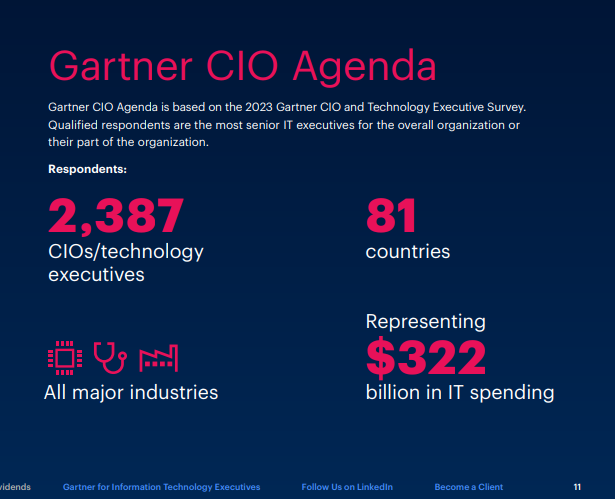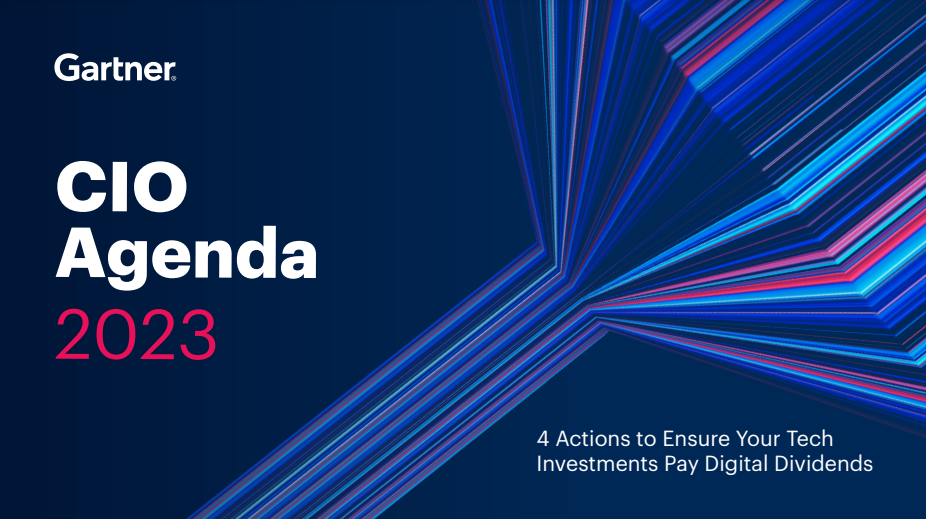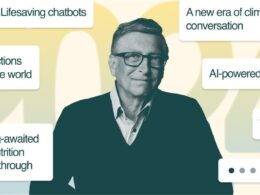Modern Health Management (MHM)
institute for continuous health transformation
Joaquim Cardoso MSc
Founder and Chief Researcher, Editor and Advisor
December 14, 2022
Key Messages:
- CEOs increasingly expect to see top- and bottom-line benefits from technology investments.
- Delivering “digital dividends” means accelerating growth beyond what was previously possible with people and machines.
- To deliver “digital dividends,” first know the financial outcomes to target.
- Then, talk about digital in terms of the collective enterprise impact, deploy digital talent to high-priority projects to speed time to impact and think outside the box to backfill everyday talent gaps.
Infographic

ORIGINAL PUBLICATION

You’re Investing More in Technology, But Is It Making Any Difference to Growth?
Gartner
November 08, 2022
Janelle Hill
The 2023 Gartner CIO and Technology Executive Agenda identifies four actions that CIOs can take to accelerate the impact of their digital technology investments.
CEOs have been increasing investments in business digitalization and information technologies since at least 2018.
With the current economic headwinds, they are losing patience; they want to see top-line or bottom-line benefits from those investments now.
With the current economic headwinds, they are losing patience; they want to see top-line or bottom-line benefits from those investments now.
The bad news for CIOs is that demonstrating tangible results poses a significant challenge. The good news is that four actions can make it easier.
Demonstrating the business value of IT remains a struggle for many CIOs — as shown by the continual demand for advice from our clients.
But in today’s souring economic conditions, CEOs are getting even more demanding — seeking proof of enterprise “digital dividends” from tech investments, not just siloed or indirect benefits.

What are digital dividends?
CEOs expect that digital technology will accelerate growth beyond what was previously possible with people and machines.
Those “digital dividends,” as we call them, are derived from augmenting the physical world with advanced digital technologies.
For example:
- Digitalizing physical assets to create smart products and services
- Digitalizing interaction channels, such as mobile apps and e-commerce
- Digitalizing business capabilities, such as “bill customer” via a touchless interface
A “digital” strategy is especially key in today’s recessionary environments, and CEOs want digital dividends — in the form of top- and bottom-line financial impact — to be delivered sooner rather than later.
Many organizations, however, are still deciphering what “digital” can mean for their business or mission.
A “digital” strategy is especially key in today’s recessionary environments, and CEOs want digital dividends — in the form of top- and bottom-line financial impact — to be delivered sooner rather than later. Many organizations, however, are still deciphering what “digital” can mean for their business or mission.

Four CIO imperatives to ensure digital dividends
Understanding exactly what financial outcomes are expected is the first of four critical steps for CIOs wanting to ensure digital dividends.
- Step №1: Prioritize the right digital initiatives
- Step №2: Create an outcome-driven metrics hierarchy
- Step №3: Contribute IT talent to a business-led fusion team
- Step №4: Reduce talent gaps with unconventional talent approaches
Step №1: Prioritize the right digital initiatives
Based on Gartner survey results, roughly half of digital initiatives don’t meet CEO or executive expectations. Most take too long to complete or too long to realize value (or both).
The greatest hindrances relate to people and organizational issues, such as siloed behavior, talent gaps, change resistance and leadership (issues exacerbated by talent shortages).
The greatest hindrances relate to people and organizational issues, such as siloed behavior, talent gaps, change resistance and leadership (issues exacerbated by talent shortages).
To overcome these inhibitors and accelerate initiatives with the greatest potential impact on enterprise financials, CIOs need to form alliances.
Prioritize in-progress initiatives based on the potential impact to the top or bottom line. To protect resources for these priority projects, be prepared to pause initiatives with less impact.
To overcome these inhibitors and accelerate initiatives with the greatest potential impact on enterprise financials, CIOs need to form alliances.
Prioritize in-progress initiatives based on the potential impact to the top or bottom line. To protect resources for these priority projects, be prepared to pause initiatives with less impact.
Any of the initiatives shown here can deliver digital dividends, but ask yourself:
- Will the enterprise’s digital initiatives support the kind of financial impact the CEO wants? (That desired impact may have changed in response to recent changes in economic conditions.)
- Are those initiatives delivering dividends in the time frame expected by the CEO? A tighter economy means the enterprise needs to realize benefits even faster.

Find digital allies in the business
Digital initiatives most often lag because of people and organizational issues, such as siloed behavior, talent gaps, change resistance and competing priorities.
Prioritize your best initiative and ally
How?
- Listen for signals about what top leaders’ priorities and concerns are, and then seek a partner in the business who shares your commitment to an initiative that targets a top priority.
OR
- Look for a business executive who has the right characteristics to be an effective partner, and then work with them to interpret signals and identify the right initiatives to pursue and challenges to overcome
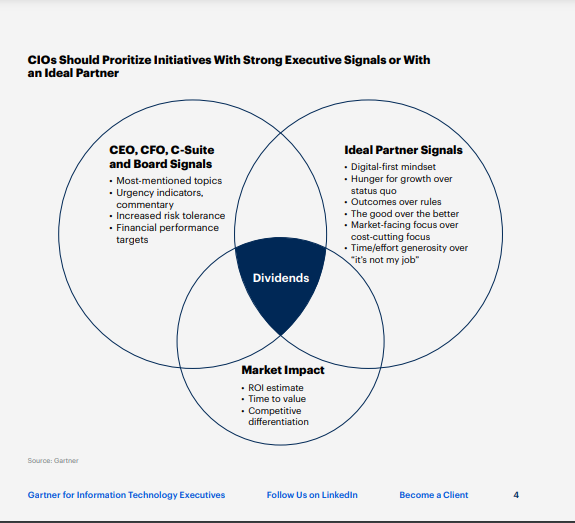
Step №2: Create an outcome-driven metrics hierarchy
Accountability is key to delivering digital benefits. However, many organizations lack visible, explicit metrics to monitor progress and attainment.
Lack of such metrics allows leaders to evade responsibility for poor results.
Accountability is key to delivering digital benefits. However, many organizations lack visible, explicit metrics to monitor progress and attainment. Lack of such metrics allows leaders to evade responsibility for poor results.
First, CIOs should identify metrics grounded in business performance and collaborate with the appropriate accountable leader to confirm what “improvement” means and how it can be measured.
For example, if the CEO’s goal is to improve profit margins, the CIO might prioritize an initiative focused on improving customer and constituent experience.
The first step for the CIO is to clarify with the CMO what success looks like — what kind of improvement should be made to deliver the improved profit margin.
Next, identify all the other initiatives underway that will collectively contribute to the desired business outcome and financial impact.
Create a visual metrics hierarchy to show the contribution of each. Metrics further down in the hierarchy are indirect.
This provides visibility into which initiatives generate desired outcomes, and who is responsible for each contributing activity within the value stream.
Create a visual metrics hierarchy
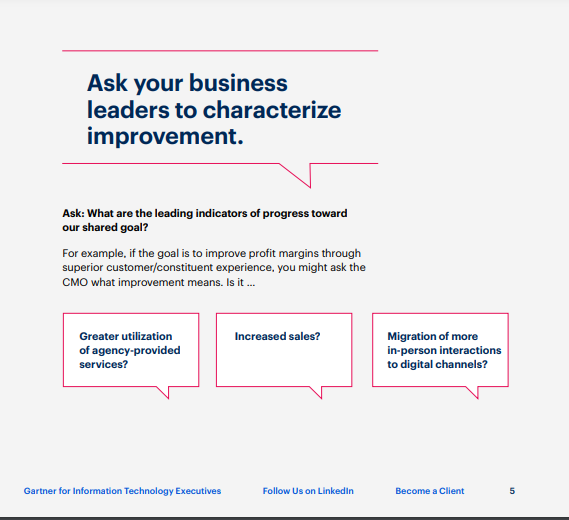
- Metrics are critical to assess progress and measure benefits.
- Many individuals lead initiatives that contribute to the desired outcome and each has their own metrics for success.
- This complicates the financial recognition of business benefits from an enterprise perspective.
For example, the IT organization may define internal operational metrics and struggle to make the connection to how these efforts ultimately affect business performance.
- The first step is to ask the CFO which financial metrics should be improved by digitalization, by how much and in what time frame.
- CIOs need to demonstrate the interdependencies across digital initiatives that will collectively impact the enterprise’s financial performance — asking, for instance, how indirect operational initiatives support direct initiatives that target market-facing business outcome metrics.
Organize metrics around desired outcomes
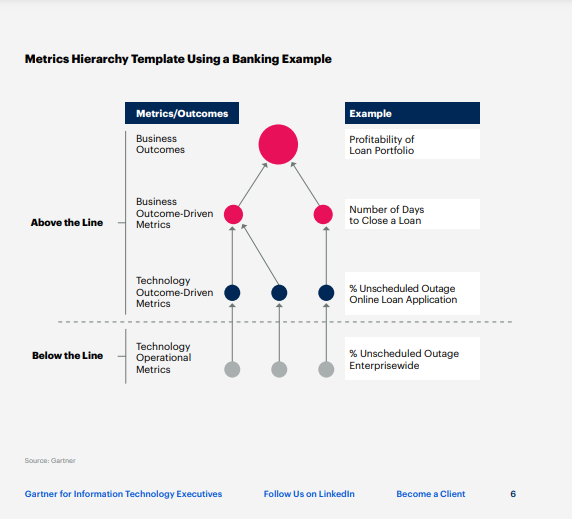
- The top-to-bottom alignment of technical and business outcome metrics reveals the performance contribution of all participants and initiatives to shared business goals.
- Metrics farther down are less direct but still roll up to the top-level metric.
- The hierarchy of initiatives collectively delivers the desired digital dividend (in this case for banking).
Step №3: Contribute IT talent to a business-led fusion team
Having identified high-impact initiatives, be sure to deploy key digital talent to big opportunities — especially ones targeted by business-led fusion teams.
The mindset within an IT organization(s) is often to go it alone in many aspects of solution delivery.
However, achieving shared goals or vision requires a range of competencies from both IT professionals and business experts, including business technologists.
…achieving shared goals or vision requires a range of competencies from both IT professionals and business experts, including business technologists.
Embrace the strengths of democratized access to technology, expertise and data.
Equip others to participate in delivering digital solutions as part of an ecosystem, breaking down psychological and bureaucratic barriers to strategic partnerships.
Building partnerships by contributing IT talent to business-led fusion teams also opens the door for integrating subject matter experts from the business into an IT-led fusion team.
This adds business perspective to internally focused initiatives and builds business acumen in IT teams — as well as accelerating the impact of the fusion teams themselves.
Contribute IT talent to fusion teams
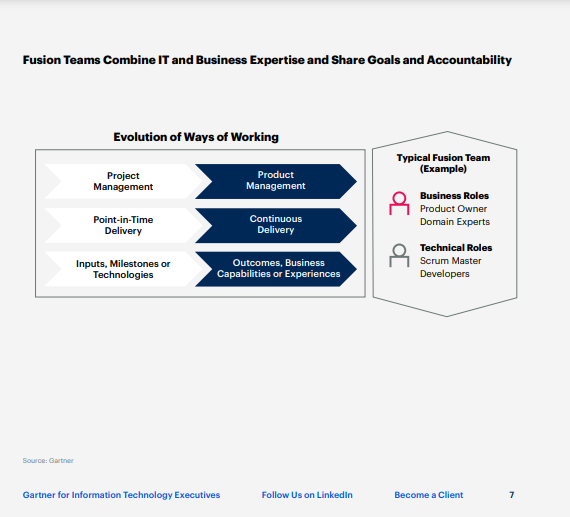
Once a high-impact digital initiative is identified, CIOs should contribute talent to the business leader who is focused on that initiative.
An effective business-led fusion team aligns subject matter experts, business technologists and IT experts around desired business outcomes, accelerating time to value.
Effective fusion teams often:
- Move to continuous digital delivery (away from project management)
- Focus on goals and performance metrics that share risks and rewards
- Use a matrix management approach to key digital talent (CIO as career manager, business leader as performance manager)
Catalyze the fusion team to accelerate digital
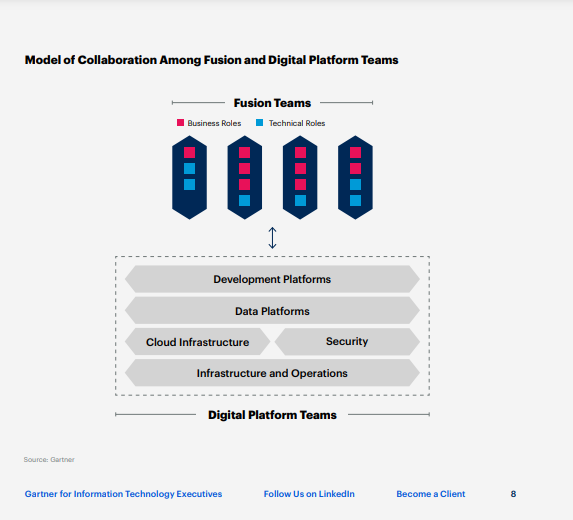
IT members of a business-led fusion team act as the CIO’s eyes and ears to better understand capabilities, data and technologies that the business initiative needs.
The CIO’s platform product manager can incorporate these requirements into the digital platforms they provide to equip other fusion teams, creating a selfsustaining feedback loop that catalyzes action.
Contributing IT talent to the business-led fusion team also opens the way for reciprocity, such as integrating subject matter experts from the business into an IT-led fusion team.
This:
- Adds business perspective to internally focused initiatives
- Builds business acumen in IT teams
- Teaches the business about architectural and security guardrails set by the IT organization to protect the enterprise
Step №4: Reduce talent gaps with unconventional talent approaches
Despite the threat of recession, the competition for digital talent remains fierce.
Many CIOs face tightening budgets and won’t be able to hire enough workers or pay for outsourcing to accelerate digital initiatives.
It’s time to consider unconventional ways to access digital skills, especially for lower-priority, internal initiatives.
Many CIOs face tightening budgets and won’t be able to hire enough workers or pay for outsourcing to accelerate digital initiatives.
While key talent contributes to high-priority actions, use nontraditional talent pools such as students and gig workers to backfill necessary but nondifferentiating business capabilities.
Unconventional talent utilization may take extra time, supervision and training, but it can often be achieved at low cost (such as hiring interns).
In addition, startups may be willing to develop assets for your enterprise if they can retain the intellectual property.
In addition, startups may be willing to develop assets for your enterprise if they can retain the intellectual property.
Find more digital talent for everyday initiatives
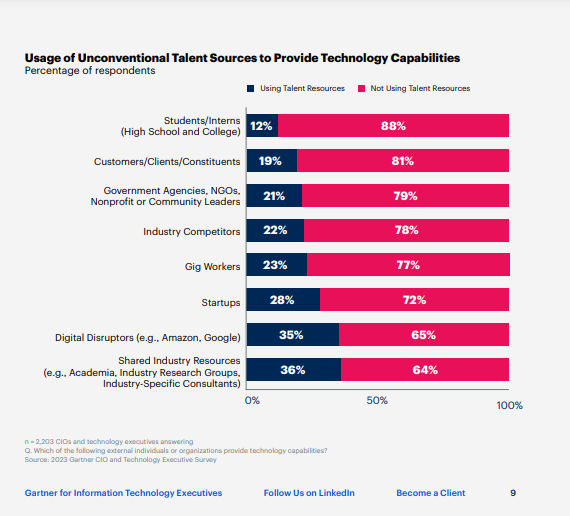
- The competition for digital talent remains fierce, despite economic slowdowns.
- As fusion teams ramp up their efforts and begin to realize value, CIOs still need digital talent to deliver on lower priority, internal initiatives.
- Our research suggests there are many untapped sources of talent suitable for this type of work.
- For example, only a few organizations regularly tap into students or cooperate with industry competitors to backfill necessary but nondifferentiating business capabilities. Most don’t use gig workers either.
Our research suggests there are many untapped sources of talent suitable for this type of work.
For example, only a few organizations regularly tap into students or cooperate with industry competitors to backfill necessary but nondifferentiating business capabilities. Most don’t use gig workers either.
Take a chance on unconventional sources

- As fusion teams start to deliver on critical digital initiatives, IT leaders can experiment with unconventional talent sourcing to progress everyday digital commitments.
- Unconventional talent takes extra time, supervision and training and a collaborative and “co-opetition” mindset.
- Many of these unconventional approaches can be accessed with low to no cost (such as interns).
- Instead, CIOs can offer experience, exposure, training or pay based on the value of the deliverable.
- CIOs in organizations with unionized labor will need to actively engage with union leaders.
- IT leaders can also create new role profiles and work with their HR partners to identify outdated policies that may keep the enterprise from quickly and easily engaging gig and other workers to create a neurodiverse work environment
IT leaders can also create new role profiles and work with their HR partners to identify outdated policies that may keep the enterprise from quickly and easily engaging gig and other workers to create a neurodiverse work environment
Janelle B. Hill is a Distinguished VP and Chief of Research for Gartner’s CIO practice. In this role, she looks across CIO research agendas to ensure they are client-centric, relevant and integrated. Her research focus is on transitioning to digital business at scale.
Originally published at https://www.gartner.com.
How the research was conducted
